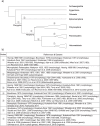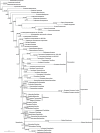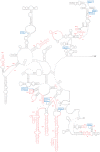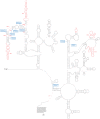A unique box in 28S rRNA is shared by the enigmatic insect order Zoraptera and Dictyoptera
- PMID: 23301099
- PMCID: PMC3536744
- DOI: 10.1371/journal.pone.0053679
A unique box in 28S rRNA is shared by the enigmatic insect order Zoraptera and Dictyoptera
Abstract
The position of the Zoraptera remains one of the most challenging and uncertain concerns in ordinal-level phylogenies of the insects. Zoraptera have been viewed as having a close relationship with five different groups of Polyneoptera, or as being allied to the Paraneoptera or even Holometabola. Although rDNAs have been widely used in phylogenetic studies of insects, the application of the complete 28S rDNA are still scattered in only a few orders. In this study, a secondary structure model of the complete 28S rRNAs of insects was reconstructed based on all orders of Insecta. It was found that one length-variable region, D3-4, is particularly distinctive. The length and/or sequence of D3-4 is conservative within each order of Polyneoptera, but it can be divided into two types between the different orders of the supercohort, of which the enigmatic order Zoraptera and Dictyoptera share one type, while the remaining orders of Polyneoptera share the other. Additionally, independent evidence from phylogenetic results support the clade (Zoraptera+Dictyoptera) as well. Thus, the similarity of D3-4 between Zoraptera and Dictyoptera can serve as potentially valuable autapomorphy or synapomorphy in phylogeny reconstruction. The clades of (Plecoptera+Dermaptera) and ((Grylloblattodea+Mantophasmatodea)+(Embiodea+Phasmatodea)) were also recovered in the phylogenetic study. In addition, considering the other studies based on rDNAs, this study reached the highest congruence with previous phylogenetic studies of Holometabola based on nuclear protein coding genes or morphology characters. Future comparative studies of secondary structures across deep divergences and additional taxa are likely to reveal conserved patterns, structures and motifs that can provide support for major phylogenetic lineages.
Conflict of interest statement
Figures





References
-
- Martynov AV (1925) Ueber zwei Grundtypen der Flugel bei den Insekten und ihre Evolution. Z Morphol Okol Tiere 4: 465–501.
-
- Crampton GC (1938) The interrelationship and lines of descent of living insects. Psyche 45: 165–181.
-
- Hennig W (1953) Kritische Bemerkungen zum phylogenetischen System der Insekten. Beitr Ent 3: 1–85.
-
- Hennig W (1969) Die Stammesgeschichte der Insekten. Frankfurt am Main: Waldemar Kramer.
-
- Hennig W (1981) Insect Phylogeny. New York: Wiley J & Sons.
Publication types
MeSH terms
Substances
Associated data
- Actions
LinkOut - more resources
Full Text Sources
Other Literature Sources
Molecular Biology Databases

